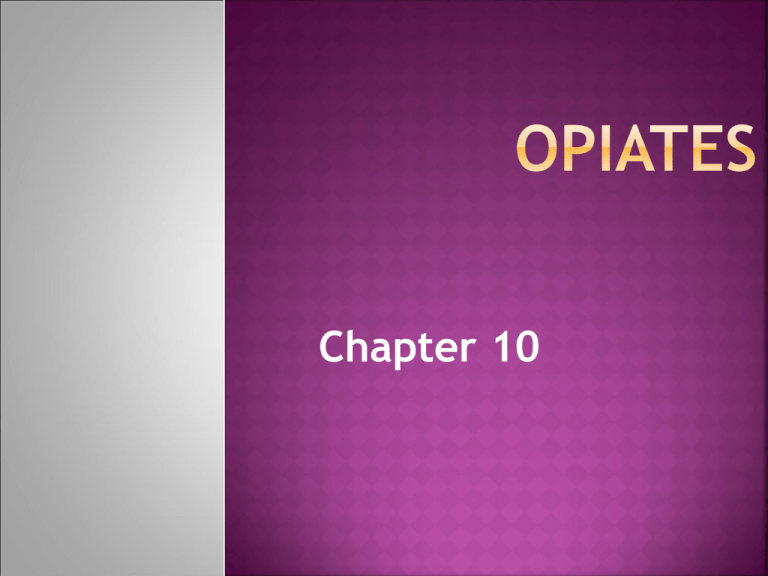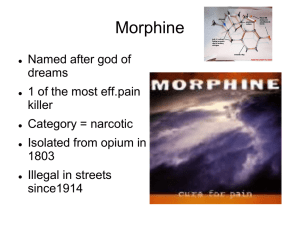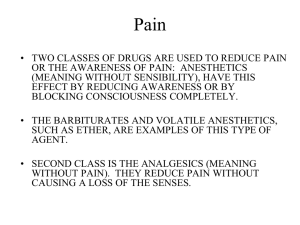The Major Narcotics - People Server at UNCW
advertisement

Chapter 10 Opiates alkaloids found in the opium poppy (Papaver somniferum) [Gk. opion = “poppy juice”] Opioids compounds with opiate-like actions, including, but not confined to opiates (e.g., synthetic, endogenous opioids) Opiates are natural and synthetic compounds that come from or are copied from OPIUM – the resin of the opium poppy Natural Narcotics Opium Extracts – Morphine & Codeine Semisynthetic Narcotics Slight changes to chemical composition of morphine Heroin Synthetic Narcotics - Produce opiate-like responses Methadone, Talwin, Darvon, Demerol BUPRENORPHINE – Partial agonist Native to many regions Middle East in areas bordering Mediterranean Laos, Thailand, Afghanistan Mexico & Colombia Use dates back 6000 years to Sumerians Egyptians used it medically 3500 years ago Common use among Islamic peoples for medical & recreational purposes Arab traders took to India & China Western Europe learned about it from Arabs during crusades 1680 Laudanum – Opium tincture (alcohol) Next 200 years, primary consumption of opium is as drink 18th century - development of opium smoking in China China - first laws against Opium use in 1729 Dependence problem recognized Western societies Used opium as aspirin Cheaper than liquor No negative public opinion No real problem with cops Used to soothe infants & children Teething, colic, or to keep them quiet Females used it more than males Greater # addicted Collision of cultures Chinese building railroad 1875 - San Francisco outlawed opium dens & opium smoking Laws targeted not at opium (laudanum legal), but at Chinese Federal laws prohibiting opium smoking followed Major difference between opium use in China & West was method of consumption Laudanum Identified with Victorian Era Opening of “respectable parlors” Chinese smoked it Identified with Opium Dens Ideal of “lazy” Chinese Seen as degrading & dirty vice 1803 - morphine separated from opium Increased dependence potential Morphine 10 X opium potency Morpheus, the Greek God of dreams 1856 - development of hypodermic needle Use became widespread Doctors began injecting opium solutions (thought to sidestep addiction, thought to be purer & safer ) Used during Civil War for injuries (dependency known as “soldier’s disease”) In 1874, British chemist altered morphine into heroin Unnoticed until rediscovered in 1898 (Bayer) 3-4 X more potent than morphine Thought to be safer than morphine Sold by Bayer - beginning in lieu of codeine as medicine for coughs, bronchitis, tuberculosis Heroin also began to replace morphine in addicted individuals Harrison Act of 1914 No ban on opiates, but doctors had to register with IRS Decreased prescriptions Users not seen as victims but as weak Heroin drug of choice in black market Shift of users from women to white urban adult males Three Crackdown caused shortage of heroin & increased smuggling & price Major Social Developments Increased levels of crime Increased used by urban minorities Drug culture Vietnam War Many veterans came back hooked Fentanyl “China White” Surgical anesthetic & prescription painkiller 10 to 10,000 X stronger than heroin Growing illegal market = growing deaths Heroin – Schedule I Morphine – Schedule II Vast majority of therapeutic opiates are synthetic Huge illegal market and trade with large dependence problem in U.S. and abroad Killers OC OXY Oxycotton Hillbilly Cotton Blue Heroin Studies indicate that the nonmedical use of prescription medications is increasing in the U.S. among adolescents and young adults. The nonmedical use of prescription medications is associated with higher rates of tobacco, alcohol and other drug use 5% of 12 to 17 year olds reported nonmedical use of scheduled pain medications*; 12% of 18 to 25 year olds reported nonmedical use of scheduled pain medications*. * lifetime 15 Percent Using in Past Year NSDUH, 2005 16 Monitoring the Future, 2005 12th grade 17 Past Year Nonmedical Use % reporting medical use * ** ** •*p < 0.05, ** p < 0.01 based on Pearson chi-square tests Source: McCabe, Teter, Boyd, 2006 18 Specific Prescription Opioids Used Nonmedically (Past Year) % The past year use was 2% or less for fentanyl, hydromorphone, meperidine, methadone, and tramadol. SLS, 2005 Source: McCabe, Cranford, Boyd19& Teter, 2007"Addict Behav Gender Differences in Motives for nonmedical Use of Prescription Opioids *** *** *p<.05, **p<.01, ***p<.001 SLS, 2005; check all that apply Source: McCabe Cranford, Boyd 20 & Teter, Add Behaviors, 2007 Most opiates poorly absorbed through GI tract (except codeine) Effective nasally and through lungs Opium frequently smoked, heroin snorted Most effective IV (heroin 100 times more potent IV than orally) In bloodstream, distributed throughout body accumulating in kidney, lung, liver, spleen, muscle & brain Opiates and blood brain barrier Morphine does not cross BBB well only 20% of circulating enters brain 30-60 min to reach significant brain concentrations Heroin more lipid soluble, so penetrates BBB better - Heroin converted to morphine once it crosses the BBB All have somewhat different pharmacological effects Differ in potency, duration of action & oral effectiveness Heroin more potent than morphine when injected, but same when taken orally Act via the endogenous opiate system 1960s - discovery of the opiate antagonist naloxone 1973 - discovery of "opiate receptors“ in brain Led to discovery of several “endogenous opiates” in 1975 Endorphin Enkephalin Dynorphin Subtype Mu (µ) Delta () Kappa () Subtypes subtypes have Primary sites of action - CNS and GI tract Abuse of opiate use due to Analgesia (best for dull continuous pain, not sharp) Due to CNS not PNS effects Euphoria (dream-like state with intense visions) Relieves negative mood states Analgesia Sedation - markedly differs between individuals • • poor sedative in general Anti-diarrheal agents • extremely effective for dysentery (1800s) were the only effective agents in that time Spinal actions inhibit incoming pain signals Projection neuron Opioid receptor Sensory neuron + Spinal cord 12.8 All classical opioid drugs of abuse have a preference for µ sites (e.g., morphine, heroin, methadone, fentanyl etc.) µ compounds: Increase DA cell firing Increase DA release in NA Kappa compounds have opposite effect Dynorphin likes kappa receptors Vomiting very common with first dose Respiratory depression Decrease sensitivity to CO2 Occurs at low doses - those common for analgesia Increase dose - increase depression Most common cause of death in overdose Biliary Constriction Body temperature Resetting of body temperature thermostat with limited use, lowers temperature by about 1 degree can persist for a month Sex hormones Inhibited Males - decreased testosterone levels, decreased sex drive Females - decreased estrogen Cardiovascular effects increased skin blood flow - gives them a warm feeling Blood pressure decrease upon standing - faint Pinpoint pupils Signs of overdose Seizures Develops fast with repeated use More rapidly and to greater degree as potency increases Constipation and biliary constriction not subject to tolerance Cross-tolerance based on receptor affinity Neuroadaptation to numerous brain areas leads to dependence Withdrawal - onset related half-life of opiate. 6-8 hrs => drug seeking behavior, restless, anxious 8-12 hrs => Pupils dilated, reactive to light; increased pulse rate, blood pressure, yawning; chills; rhinorrhea; lacrimation; gooseflesh; sweating; restless sleep 48-72 hrs (peak) => All of the above plus muscular weakness, aches (cramps) and twitches; nausea, vomiting and diarrhea; temperature and respiration rate elevated; heart rate and blood pressure elevated; dehydration. Withdrawal – managed in a number of ways Cold Turkey Medically managed Ultra-rapid Detox Methadone used as a replacement for heroin and other opiates in dependent individuals Longer half-life Slower, less intense effects – no euphoria Can be taken orally – no needles Cheap Blocks heroin effect Methadone withdrawal 24-48 hrs after last dose withdrawal symptoms reported to be less intense however, much greater duration can take months to clear all withdrawal symptoms Partial Low levels = agonist High levels = antagonist Can Agonist be managed by physician Taken sublingually every 24-48 hours Can bridge the gap between methadone and nothing or used long-term











